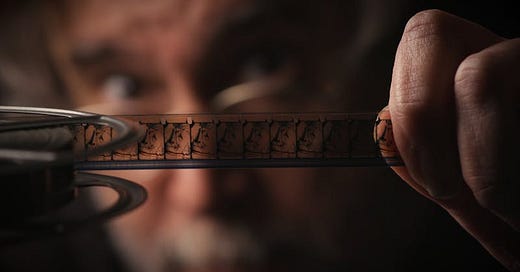Indy Film Fest: Film Is Dead. Long Live Film.
A terrific documentary for lovers of celluloid, chronicling the kooks and keepers of the flame working behind the scenes to save film from extinction.
For Indy Film Fest schedule and tickets, please click here.
It seems not that long ago that digital projection was a new thing at movie theaters. Critics and complainers noted the quality wasn’t as good as celluloid, but as with all things the technology improved and soon digital caught up.
Now, according to the documentary “Film Is Dead. Long Live Film.” from director Peter Flynn, less than 2 percent of theaters even have the capacity to show old-school film, many of those being IMAX. It’s much less expensive to download movies to cinemas (or send as hard drives or discs) than ship heavy cans of film reels, which have to be painstakingly assembled by the projectionist and then broken down and returned after their run.
Not to mention, celluloid is rather delicate stuff, prone to breaks and scratching. It’s also highly flammable.
Perhaps that’s why studios, even going back to the early days of Hollywood, did not treat their films as anything other than disposable entertainment. Some movies were stored carefully in cool, dry vaults. But many others were simply thrown away. It’s estimated that as much as 90% of the movies ever made are lost for all time.
You’ll learn much about the history of celluloid in “Film Is Dead.” But mostly the story is one of people — specifically, the preservationists and collectors working hard behind the scenes, usually on their own dime, to find and restore lost films for the rest of us to enjoy.
Some of the things you’ll see in the documentary are just astounding. Footage from the Lindberg trial thought destroyed. Sammy Davis Jr.’s performance right before the car accident that would cost him his eye. Entire films, like “King of the Congo,” that were thought gone the way of the dodo, now refurbished to beautiful condition and projected onto screens again.
We are also instructed about the physical nature of film. Nitrate, the most popular type early on, is so combustible it’s been known to blow out the walls of collectors’ homes where they thought it’d been safely stored. Acetate, aka “safety film,” came along later on but is still heady stuff.
Old film takes on a vinegary smell, and a common scene in the documentary is a collector sniffing reels to get an idea of how far gone they are — connoisseurs of decay.
The audience is also instructed on the various formats of film, from the 35mm that became standard to the 16mm and 8mm geared more toward classrooms and home movies, going all the way up to the granddaddy 70mm — still the king of exhibition. You’ll be astonished to learn you could buy cut-down prints of movies still showing in theaters for home use — even fare like “Star Wars.”
We get to meet many of the great collectors, guys like Louis DiCrescenzo and Stu Fink, often former projectionists or workers on the fringes of the movie industry who took it upon themselves to find and recover every last scrap of film they could — not just feature films but television shows, commercials, newsreels and promo footage. Their houses groan with boxes of reels in every corner and nook. One refers to himself as an archaeologist, trolling shut-down movie theaters and offices in search of celluloid.
Almost entirely older men, they’re undeniably kooks — but also keepers of the sacred flame.
Back in high school and college working in movie theaters, I trained to be a backup projectionist. So I got to know how to run 35mm projectors, and even 70mm. I had the pleasure of helping break down the last theatrical release in 70mm, 1992’s “Far and Away.” I knew it was going to be discarded, so I snipped a few frames from my favorite scene and used it as a bookmark for many years.
Even as these ardent lovers of film will tell you, ultimately it’s not the pieces of celluloid themselves that matter, but what’s on it — the images that move us. This is a lovely piece of storytelling about strangers often regarded suspiciously by the studios, even prosecuting them for piracy, but who then came running when they needed help reassembling footage for a restoration.
“Film Is Dead. Long Live Film.” is about the past, but also our future. Hold on to what we have, and share, share, share.





